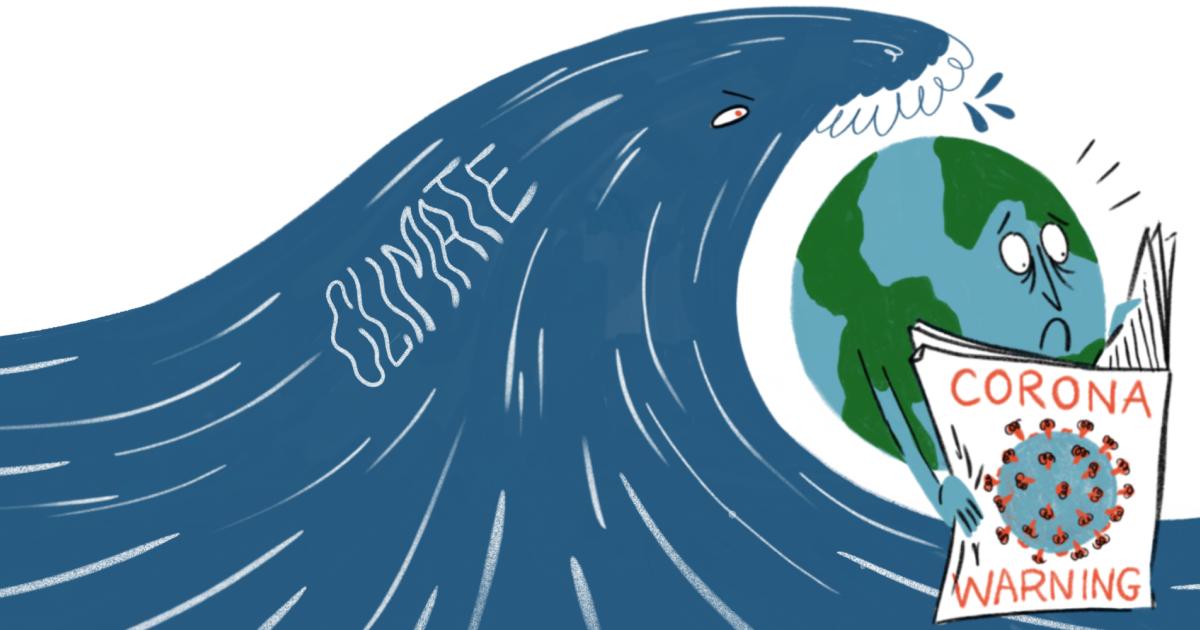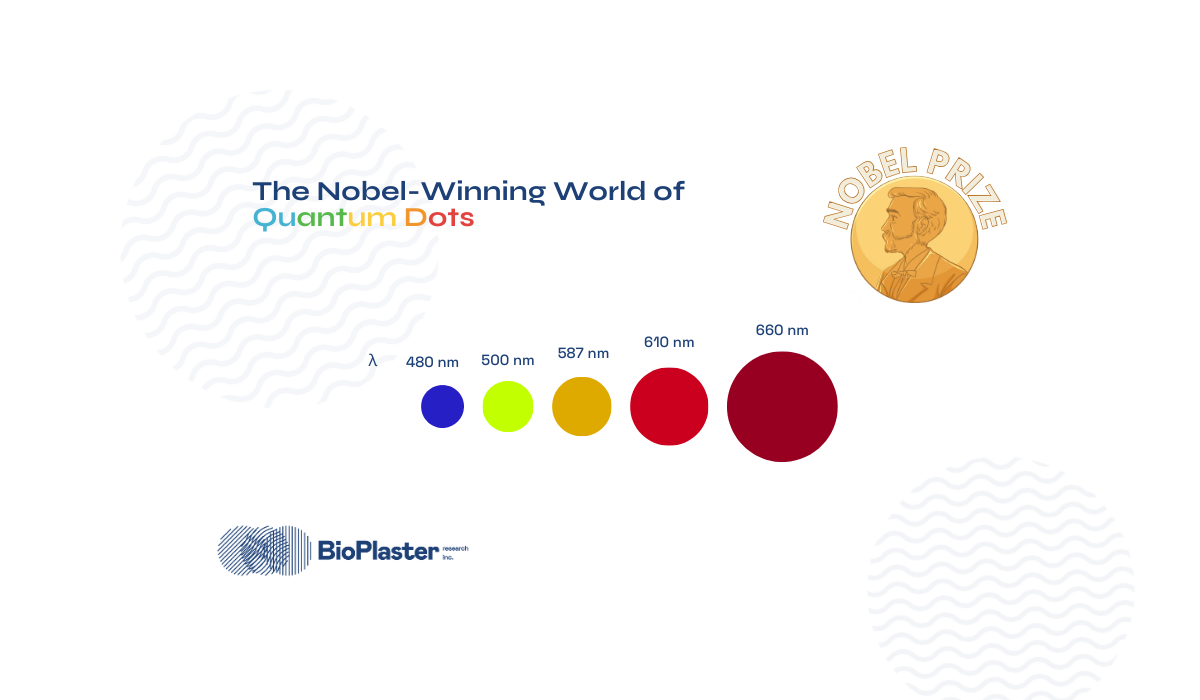Since 1995, it has been suggested that the emergence of new zoonoses or diseases that spread from animals to people is probably correlated with the intensive use of natural resources, which cause environmental damage, loss of biodiversity and ultimately vulnerability to face a health emergency [1]. This suggestion has gained more force if we compare the appearance of new zoonotic outbreaks from 1996 to the most recent one in 2021 (see Figure 1). Since 2003, there have been global outbreaks of SARS (acute respiratory syndrome), H1N1 influenza in 2009-2010, MERS (Middle East Respiratory Syndrome) in 2012, Ebola in Africa in 2013-2016, and the Zika virus pandemic of 2015-2016 [2].
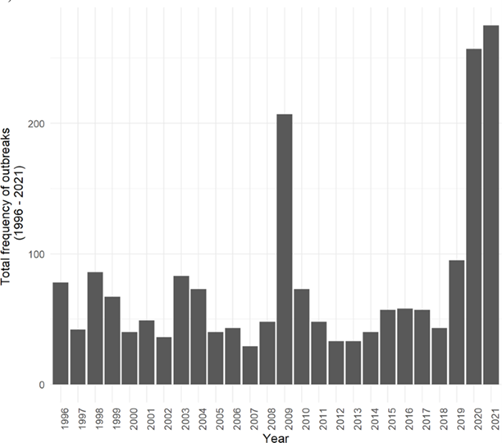
By placing the number of outbreaks between 2016 and 2021 on a global map, we see that these diseases occurred in practically all countries and on all continents, see Figure 2.
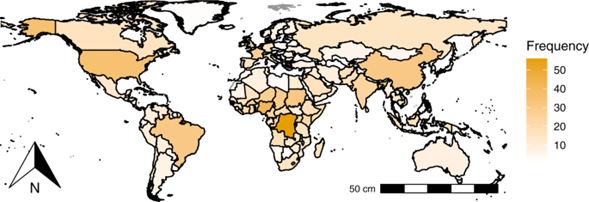
Until now, we have undoubtedly recognized that there has been a greater frequency of pandemic outbreaks in the last 20 years, but the central question is whether this higher frequency is correlated with a greater exploitation of natural resources valuable for the development of our societies, from raw materials such as cellulose from wood resources, to the exploitation of mines to obtain metals for the manufacture of semiconductors, ceramics and resins. In addition to the above, we must consider the weight of climate change and how it forms part of an intricate network of causes and effects with global consequences [3]. In this regard, a series of vectors have been analyzed between climatic conditions and changes in ecosystems and their biodiversity in the case of new coronaviruses, as follows (see Figure 3).
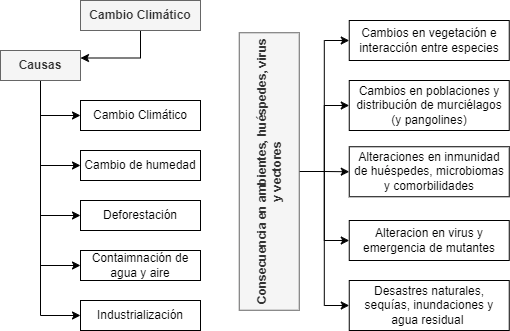
The different climatic parameters are modified from temperature to humidity, which affect the interactions of hosts (human), vectors (an insect or other animal) and the virus itself. Productive activities and climate change significantly affect the habitat distribution of vectors (such as bats and pangolin, which are believed to be zoonotic intermediaries in COVID-19). Changes in land use for construction, deforestation and increased water and air pollution result in interaction between species, which increase the efficiency of virus transmission and affect the hosts' immune system.
Let's take the case of COVID-19 for a moment and since we connect loose ends with bats, referring to the question of the title of this essay -which up to this point is expected to make sense-, we could propose what Gupta et al. (2021) have suggested:
...” The effect of climate change on bats and their habitat and its probable correlation with the emergence of SARS-CoV-2 includes many anthropogenic interventions on the natural habitat of bats, which as a result has led to a greater likelihood of contact with humans, who are susceptible to SARS-CoV-2. Climatic variations and anthropogenic factors have resulted in increased stress on bats themselves, which carry several coronaviruses. Such changes in bat physiology have aided in the creation of mutant variants capable of infecting humans.”.
Our ability to prevent future pandemics and be prepared in the precise place where they will occur is still limited, but what we do know is that there is a link with the modification of the habitat of carriers (animals and insects). Normally, this modification is driven by agriculture, which is already recognized as the main factor that ensures the emergence of new diseases in the future [4] [5]. In this sense, proposals and studies on the use and exploitation of natural resources have been extensive and varied from the point of view of the circular economy, the planetary boundaries proposed by Johan Röckstrom, or of an economy limited to regional and increasingly local borders, as well as the search and research of innovative materials that are compatible with natural habitats.
A very clear example that connects intensive agriculture with the sea is the recurrence of a mass of sargassum in the Atlantic [6]. This giant mass of algae that was originally named by Christopher Columbus's sailors as Salgaso, since they were reminiscent of a variety of small grapes from Portugal [6], they can be natural sources of alginates, cellulose and fucoidans. Alginates are sugar polymers of maluronic (M) and guluronic (G) acid connected in G-G, M-M, or G-M tandem blocks with various applications from the cosmetic, food and pharmaceutical industries as thickening agents, foaming agents, emulsion stabilizers, and others. In the case of cellulose, they are connected glucose chains that form part of the cell walls of plants and algae. The main uses range from the best known in the paper industry to the least widespread, such as the manufacture of nanoparticles or microfibers for the textile industry. Finally, fucoidans are extensively researched in various fields of biomedicine as anti-inflammatories, inhibitors of cell adhesion interaction and blockers in the molecular recognition of proteins.
In light of the fact that the intensive agriculture that causes the increase of sargassum in the Atlantic, it can be valued depending on the philosophical point of view, either part of a circular system of regional boundaries that comprise the Caribbean Sea, which extends from South America to the coast of Florida, passing through the Mexican Caribbean, or as a planetary response that, as a serious consequence, fragment the planetary boundaries of biodiversity, since paradoxically, despite the fact that the marine environment where it grows is rich in nutrients, it is in turn a desert biologically, this is known as the Ryther paradox [6].
ENBioPlaster Research Inc. We are aware that the design and research of materials is something more profound and complex, requiring the study of raw materials that cause the least possible impact, from their extraction or synthesis to their final disposal. The next time you consider the use and exploitation of material resources, consider in Christian terms if it's like a bat broth that would cause the next pandemic.
Reference:
[1] Madhav N, Oppenheim B, Gallivan M, et al. Pandemics: Risks, Impacts, and Mitigation (2018) In: Jamison DT, Gelband H, Horton S, et al., editors. Disease Control Priorities: Improving Health and ReducingPoverty. 3rd edition. Washington (DC): The International Bank for Reconstruction and Development/The World Bank. Chapter 17. Available from: https://www.ncbi.nlm.nih.gov/books/NBK525302/ doi: 10.1596/978-1-4648-0527-1_ch17
[2] Torres Munguia, J.A., Badarau, F.C., Díaz Pavez, L.R. et al. (2022) A global dataset of pandemic- and epidemi-pronedisease outbreaks. Sci Data 9, 683
[3] Gupta, S., Rouse, B.T., & Sarangi, P.P. (2021). Did Climate Change Influence the Emergence, Transmission, and Expression of the COVID-19 Pandemic? In Frontiers in Medicine (Vol. 8)
[4] Jones, B.A., Grace, D., Kock, R., Alonso, S., Rushton, J., Said, M.Y., McKeever, D., Mutua, F., Young, J., McDermott, J., &Pfeiffer, D.U. (2013). Zoonosis emergence linked to agricultural intensification and environmental change. Proceedings of the National Academy of Sciences, 110 (21), 8399—8404;
[5] Lawler OK, Allan HL, Baxter PWJ, Castagnino R, Tor MC, Dann LE, Hungerford J, Karmacharya D, Lloyd TJ, López-Jara MJ, Massie GN, Novera J, Rogers AM, Kark S. The COVID-19 pandemic is intricately linked to biodiversity loss and ecosystem health. Lancet Planet Health. 2021 Nov; 5 (11): e840-e850
Our Blog
At Bio+ we share relevant articles, research and news about innovation in bioplastics, sustainability and the environmental impact of materials. Find out how we're working for a more regenerative future.

